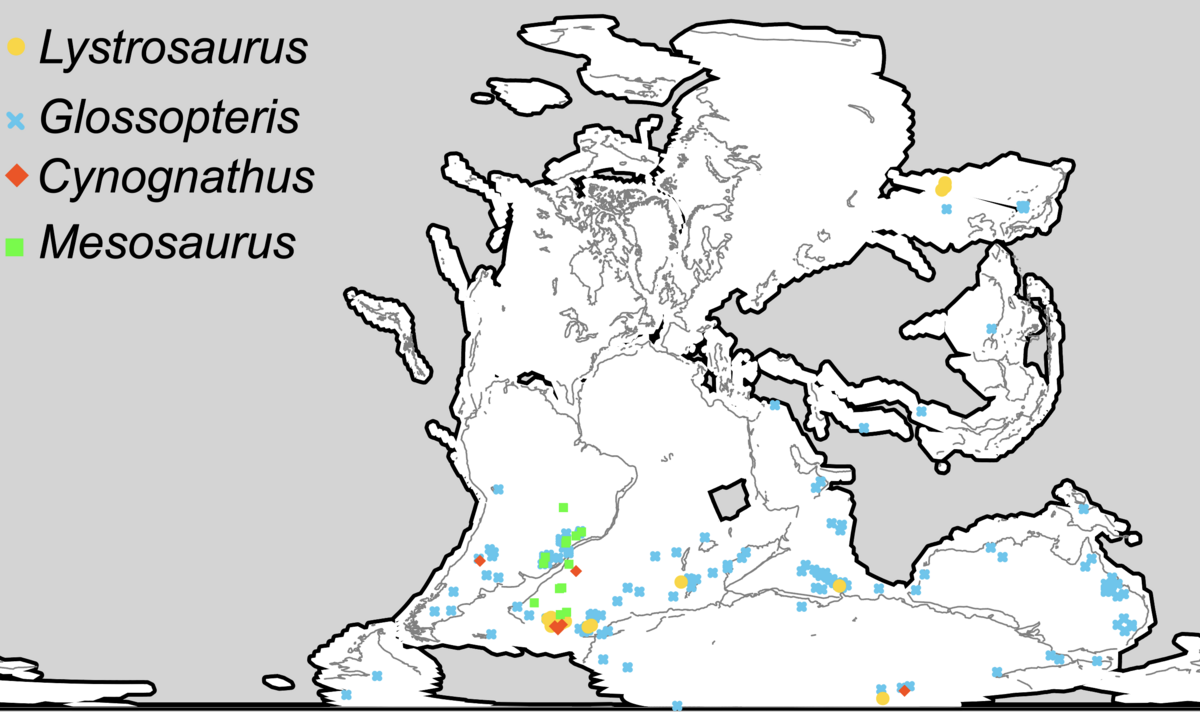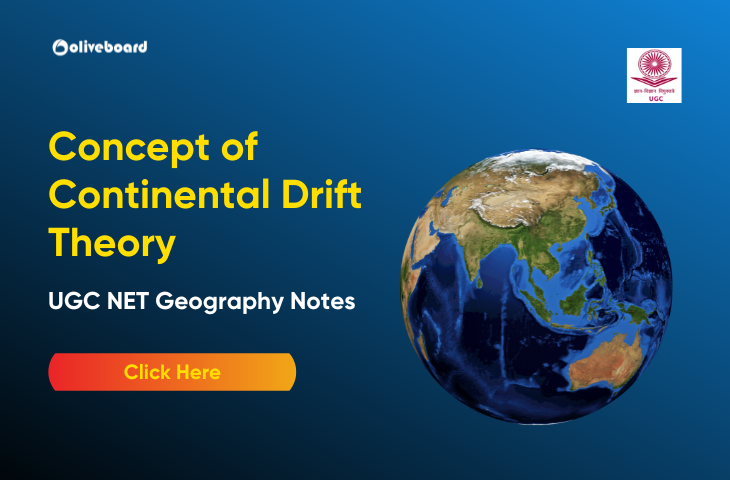Concept of Continental Drift Theory: The Concept of Continental Drift Theory was first proposed by Alfred Wegener in 1912, explaining the movement of Earth’s continents over geological time. This theory suggests that continents were once part of a single supercontinent, Pangaea, which gradually drifted apart due to tectonic forces. The idea laid the foundation for modern plate tectonics and revolutionized our understanding of Earth’s geological history.
For UGC NET Geography, understanding continental drift evidence, the role of seafloor spreading, and how tectonic plate movements shape landforms is essential. This topic is crucial in geophysical studies, earth sciences, and competitive exams, where questions often focus on continental drift theory and plate tectonics and their real-world implications. Read the full article to know more about the Continental Drift Theory.
Historical Background of Concept of Continental Drift Theory
The continental drift hypothesis was first proposed by Alfred Wegener in 1912, suggesting that continents were once part of a single supercontinent called Pangaea and gradually drifted apart. Wegener presented his ideas in his book Die Entstehung der Kontinente und Ozeane (The Origin of Continents and Oceans) in 1915.
Initially, the scientific community rejected Wegener’s theory due to the lack of a convincing mechanism for continental movement. However, supporting evidence from fossil distribution, geological formations, and paleoclimatic data kept the idea relevant. The discovery of seafloor spreading by Harry Hess (1960s) and advancements in plate tectonics theory provided the missing mechanism, leading to the eventual acceptance of continental drift and plate tectonics as a unified model in modern geology.
Key Evidence Supporting Continental Drift Theory
The Concept of Continental Drift Theory is backed by strong scientific evidence, including fossil similarities, geological formations, climatic patterns, and paleomagnetic studies, proving that continents have moved over time.
1. Fossil Evidence

- Identical fossils of species like Mesosaurus (a freshwater reptile) and Glossopteris (a plant) found on continents separated by oceans.
- Suggests these landmasses were once connected, supporting the continental drift hypothesis.
2. Geological Evidence
- Matching rock formations and mountain ranges across continents (e.g., Appalachians in North America align with Caledonian mountains in Europe).
- Similar coal deposits and geological structures found on widely separated continents.
3. Climatic Evidence
- Presence of glacial deposits in tropical regions like India, Africa, and South America indicates these continents were once closer to the South Pole.
- Contradicts current climatic conditions, proving past continental movements.
4. Paleomagnetic Studies & Oceanic Crust Movements
- Magnetic minerals in rocks show changes in Earth’s magnetic field, proving continents shifted over time.
- Seafloor spreading (discovered by Harry Hess) provided solid proof of tectonic plate movements, reinforcing continental drift and plate tectonics theory.
Also Read: Theory of Plate Tectonics
Mechanism Behind Continental Drift
The Concept of Continental Drift Theory is powered by deep geological forces that constantly reshape Earth’s surface. These forces include mantle convection, seafloor spreading, tectonic plate interactions, mid-ocean ridges, and subduction zones. Let’s break them down:
1. Mantle Convection – The Engine of Continental Drift
- Beneath Earth’s crust lies the mantle, a semi-molten layer where convection currents occur.
- Heat from Earth’s core causes hot magma to rise and cool magma to sink, creating a slow-moving cycle.
- These convection currents push and pull tectonic plates, driving continental drift.
2. Seafloor Spreading – The Expanding Ocean Floor
- Discovered by Harry Hess, seafloor spreading explains how new oceanic crust forms at mid-ocean ridges.
- Molten rock rises, cools, and solidifies, pushing older crust away, causing continents to move apart.
- This process provides strong evidence for plate tectonics and continental movement.
3. Tectonic Forces – The Movers of Continents
- Divergent Boundaries: Plates move apart (e.g., Mid-Atlantic Ridge, separating South America and Africa).
- Convergent Boundaries: Plates collide, forming mountain ranges like the Himalayas.
- Transform Boundaries: Plates slide past each other, triggering earthquakes (e.g., San Andreas Fault).
4. Mid-Ocean Ridges & Subduction Zones – The Recycling System
- Mid-ocean ridges create new crust, pushing continents apart.
- Subduction zones (like the Pacific Ring of Fire) pull old crust into the mantle, recycling Earth’s surface.
- This balance of creation and destruction keeps the continents in motion.
Why It Matters?
- The Concept of Continental Drift Theory is more than just history, it explains earthquakes, volcanic activity, mountain formation, and oceanic changes.
- It revolutionized geology and remains a cornerstone of Earth sciences today.
Impact of Continental Drift on Modern Geography
The Concept of Continental Drift Theory has profoundly shaped modern geography, geology, and Earth sciences, explaining key natural phenomena and the evolution of Earth’s surface.
1. Influence on Earthquakes, Volcanic Activity & Mountain Formation
- Earthquakes occur due to the movement of tectonic plates along fault lines (e.g., San Andreas Fault).
- Volcanic activity is concentrated in subduction zones and mid-ocean ridges, forming volcanic islands and arcs (e.g., Pacific Ring of Fire).
- Mountain ranges like the Himalayas and Andes formed due to continental collisions, proving large-scale landmass movements.
2. Connection with Plate Tectonics & Global Landmass Distribution
- The theory explains how continents shift, break apart, and reassemble, influencing climate, ocean currents, and biodiversity.
- The movement of tectonic plates determines the position of continents and ocean basins, impacting global ecosystems.
3. Importance in Geophysical Studies & Environmental Sciences
- Helps predict seismic activity, volcanic eruptions, and natural disasters, aiding disaster management.
- Provides insights into climate change, continental weathering, and resource distribution (e.g., fossil fuels, minerals).
- Supports paleogeographic research, helping scientists reconstruct Earth’s ancient landscapes.
The Concept of Continental Drift Theory remains a cornerstone of Earth sciences, influencing modern research on tectonic processes, natural hazards, and global environmental changes.
Criticism and Limitations of Continental Drift Theory
Despite its groundbreaking insights, the Concept of Continental Drift Theory faced strong opposition in its early days due to several limitations:
1. Lack of a Driving Mechanism
- When Alfred Wegener proposed the theory in 1912, he couldn’t explain how continents moved.
- He suggested forces like Earth’s rotation and tidal forces, but these were scientifically weak and dismissed by geologists.
2. Rejection by the Scientific Community
- Geologists in the early 20th century believed continents were fixed and immovable.
- Without evidence of a powerful force driving continental movement, the theory lacked acceptance.
3. Plate Tectonics – The Missing Link
- The discovery of seafloor spreading (Harry Hess, 1960s) provided a solid explanation for continental movement.
- Mantle convection currents were identified as the actual driving force behind tectonic plate movements.
- The theory of plate tectonics combined these discoveries, resolving criticisms and confirming continental drift as part of modern geology.
Thus, while Wegener’s idea was initially dismissed, plate tectonics theory validated his insights, making the Concept of Continental Drift a key pillar of Earth sciences today.
Concept of Continental Drift Theory Conclusion
The Concept of Continental Drift Theory, proposed by Alfred Wegener in 1912, revolutionized geology by proving that continents were once connected as Pangaea and later drifted apart. Initially rejected due to the lack of a driving mechanism, it was later validated by plate tectonics theory, supported by seafloor spreading and mantle convection. This theory remains essential in understanding earthquakes, volcanic activity, mountain formation, and global landmass distribution, laying the foundation for modern geology and geophysics.
Also Check: UGC NET Geography Exam Analysis 2024
Continental Drift Theory FAQs
Ans: The Continental Drift Theory was proposed by Alfred Wegener in 1912, suggesting that continents were once connected and have since drifted apart.
Ans: The theory states that all continents were once part of a single supercontinent called Pangaea, which later broke apart and drifted to their current positions.
Ans: The theory was initially rejected because Wegener could not explain the mechanism that caused continents to move, and his ideas contradicted existing geological beliefs.
Ans: Continental movement is driven by mantle convection currents, seafloor spreading, and tectonic plate interactions, which continuously reshape Earth’s surface.
Ans: The theory gained acceptance after the discovery of seafloor spreading by Harry Hess in the 1960s, which provided a scientific explanation for continental movement through plate tectonics.
Hello there! I’m a dedicated Government Job aspirant turned passionate writer & content marketer. My blogs are a one-stop destination for accurate and comprehensive information on exams like Regulatory Bodies, Banking, SSC, State PSCs, and more. I’m on a mission to provide you with all the details you need, conveniently in one place. When I’m not writing and marketing, you’ll find me happily experimenting in the kitchen, cooking up delightful treats. Join me on this journey of knowledge and flavors!

